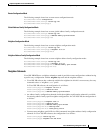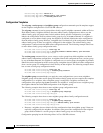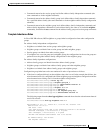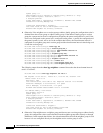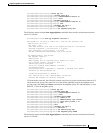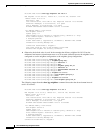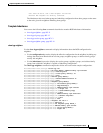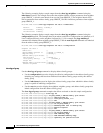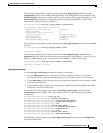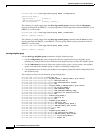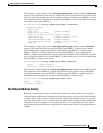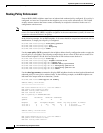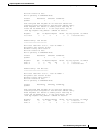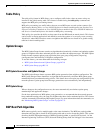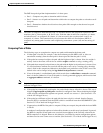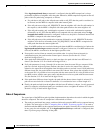
Implementing BGP on Cisco IOS XR Software
Information About Implementing BGP on Cisco IOS XR Software
RC-13
Cisco IOS XR Routing Configuration Guide
The following example displays sample output from the show bgp af-group command using the
configuration keyword. This example shows from where each configuration item was inherited. The
default-originate command was configured directly on this address family group (indicated by [ ]). The
remove-private-as command was inherited from address family group GROUP_2, which in turn
inherited from address family group GROUP_3:
RP/0/RP0/CPU0:router# show bgp af-group GROUP_1 configuration
af-group GROUP_1 address-family ipv4 unicast
capability orf prefix-list both [a:GROUP_2]
default-originate []
maximum-prefix 2500 75 warning-only []
route-policy POLICY_1 in [a:GROUP_2 a:GROUP_3]
remove-private-AS [a:GROUP_2 a:GROUP_3]
send-community-ebgp [a:GROUP_2]
send-extended-community-ebgp [a:GROUP_2]
The following example displays sample output from the show bgp af-group command using the users
keyword:
RP/0/RP0/CPU0:router# show bgp af-group GROUP_2 users
IPv4 Unicast: a:GROUP_1
The following example displays sample output from the show bgp af-group command using the
inheritance keyword. This shows that the specified address family group GROUP_1 directly uses the
GROUP_2 address family group, which in turn uses the GROUP_3 address family group:
RP/0/RP0/CPU0:router# show bgp af-group GROUP_1 inheritance
IPv4 Unicast: a:GROUP_2 a:GROUP_3
show bgp session-group
Use the show bgp session-group command to display session groups:
• Use the configuration keyword to display the effective configuration for the session group,
including any settings that have been inherited from session groups used by this session group.
• Use the inheritance keyword to display the session groups from which this session group is capable
of inheriting configuration.
• Use the users keyword to display the session groups, neighbor groups, and neighbors that inherit
configuration from this session group.
The examples that follow sample output from the show bgp session-group command with the
configuration keyword in EXEC mode. The examples are based on the following session group
configuration:
RP/0/RP0/CPU0:router(config)# router bgp 140
RP/0/RP0/CPU0:router(config-bgp)# session-group GROUP_1
RP/0/RP0/CPU0:router(config-bgp-sngrp)# use session-group GROUP_2
RP/0/RP0/CPU0:router(config-bgp-sngrp)# update-source Loopback 0
RP/0/RP0/CPU0:router(config-bgp-sngrp)# exit
RP/0/RP0/CPU0:router(config-bgp)# session-group GROUP_2
RP/0/RP0/CPU0:router(config-bgp-sngrp)# use session-group GROUP_3
RP/0/RP0/CPU0:router(config-bgp-sngrp)# ebgp-multihop 2
RP/0/RP0/CPU0:router(config-bgp-sngrp)# exit
RP/0/RP0/CPU0:router(config-bgp)# session-group GROUP_3
RP/0/RP0/CPU0:router(config-bgp-sngrp)# dmz-link-bandwidth
The following is sample output from the show bgp session-group command with the configuration
keyword in EXEC mode:



